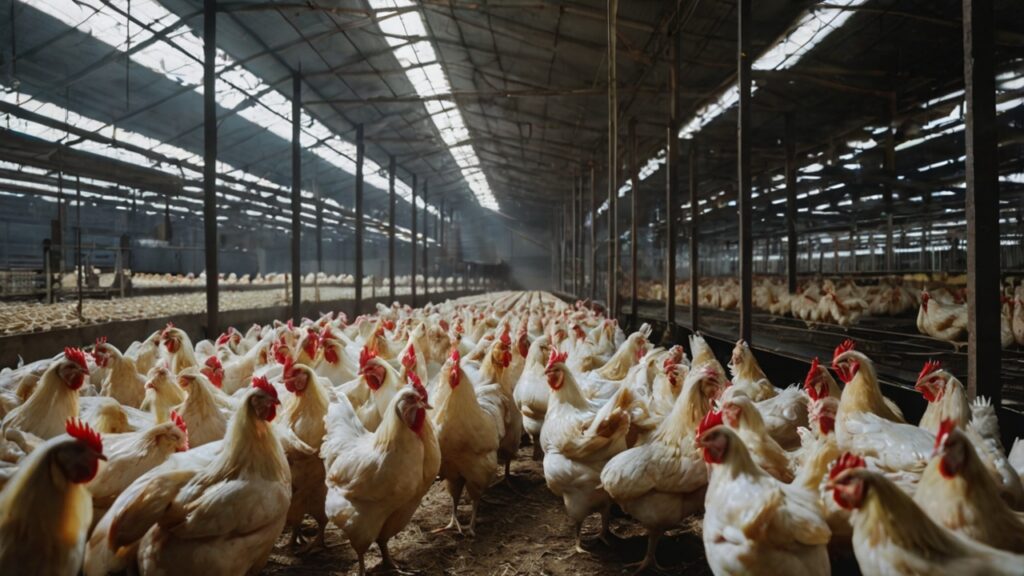
Summer heat waves pose severe challenges for poultry farmers, leading to heat stress, dehydration, reduced productivity, and increased disease outbreaks. Effective summer management is crucial to maintain flock health, optimize growth (broilers), sustain egg production (layers), and ensure fertility (parent stock).
This guide covers:
✅ Understanding heat stress & its effects
✅ Housing & ventilation management (low-cost & advanced solutions)
✅ Water & feed strategies to combat dehydration
✅ Common summer diseases & prevention
✅ Special care for broilers, layers, and breeders
✅ Emergency heatwave measures
✅ Budget vs. advanced farm solutions
1. Understanding Heat Stress in Poultry
Why Are Poultry Birds Vulnerable to Heat?
- No sweat glands → Birds rely on panting to cool down.
- High metabolic rate → More body heat production.
- Feather insulation → Traps heat in summer.
Effects of Heat Stress on Different Flocks
| Parameter | Broilers | Layers | Parent Stock |
|---|---|---|---|
| Feed Intake | ↓ 10-30% | ↓ 5-20% | ↓ 15-25% |
| Weight Gain | ↓ 20-50% | N/A | ↓ (Males affected more) |
| Egg Production | N/A | ↓ 10-40% | ↓ Fertility & hatchability |
| Mortality | ↑ 5-20% | ↑ 3-15% | ↑ (Especially males) |
Critical Temperature & Humidity Levels
- Comfort Zone: 65-75°F (18-24°C) with 50-70% humidity.
- Danger Zone: Above 85°F (30°C) → Heat stress begins.
- Extreme Danger: Above 95°F (35°C) → Risk of mass mortality.
2. Housing & Ventilation Management
A. Natural Ventilation (Low-Cost Solutions)
- Open-Sided Sheds with Adjustable Curtains
- Allows cross-ventilation.
- Use wet gunny bags on sides for evaporative cooling.
- Roof Insulation Techniques
- Thatched roofs (Cheapest but less durable).
- Reflective white paint (Reduces heat absorption).
- Double roofing (Air gap between two layers reduces heat transfer).
- Shade Management
- Planting trees (Neem, Moringa) around sheds.
- Green net shade (30-50% shade factor).
B. Artificial Cooling (Advanced Systems)
- Foggers & Misting Systems
- Best for low-humidity regions (<60% RH).
- Run for 2-3 mins every 15 mins to avoid wet litter.
- Cooling Pads (Evaporative Cooling)
- Cools air by 5-10°F before entering sheds.
- Requires electricity & water supply.
- Tunnel Ventilation + Exhaust Fans
- Ideal for closed houses.
- Fans pull air at 500-600 ft/min for wind chill effect.
3. Water Management to Prevent Dehydration
Key Strategies
✔ Increase water space:
- Nipple drinkers: 1 nipple per 8-10 birds.
- Bell drinkers: 1.5 cm linear space per bird.
✔ Keep water cool (60-70°F):
- Bury water tanks underground.
- Paint tanks white to reflect sunlight.
✔ Electrolytes & Supplements:
- Vitamin C (1g/liter) → Reduces stress.
- Potassium & Sodium → Restore lost minerals.
Avoid Over-Watering Risks
- Wet litter → Increases ammonia & fungal growth.
- Solution: Use rice husk or wood shavings for better absorption.
4. Feed Management in Summer
A. Adjusting Feeding Schedule
- Feed early morning (4-6 AM) & late evening (6-8 PM).
- Avoid feeding between 11 AM – 4 PM (Peak heat hours).
B. Modifying Feed Composition
| Nutrient | Summer Adjustment | Reason |
|---|---|---|
| Energy | ↑ (Add 2-5% fat/oil) | Compensate for low intake |
| Protein | ↓ (Reduce by 1-2%) | Less heat production |
| Vitamins | ↑ (Vit C, E, B-Complex) | Reduce stress |
C. Feed Additives for Heat Stress
- Probiotics → Improve gut health.
- Organic acids (Acetic, Citric) → Prevent bacterial growth.
- Antioxidants (Selenium, Vit E) → Protect cells from heat damage.
5. Common Summer Diseases & Prevention
A. Necrotic Enteritis (Clostridium perfringens)
- Causes: Heat stress → Gut imbalance → Bacterial overgrowth.
- Symptoms:
- Bloody diarrhea.
- Sudden death in broilers.
- Prevention:
- Probiotics (Bacillus subtilis).
- Acidifiers in water (Vinegar, 1ml/liter).
B. Coccidiosis (Eimeria spp.)
- Causes: Wet litter → Parasite thrives.
- Symptoms:
- Watery/bloody droppings.
- Pale combs & weight loss.
- Treatment:
- Amprolium (0.012% in water for 5 days).
- Toltrazuril (7 mg/kg for 2 days).
C. Fowl Cholera (Pasteurella multocida)
- Causes: Contaminated water, stress.
- Symptoms:
- Swollen wattles, green diarrhea.
- Sudden death.
- Treatment:
- Oxytetracycline (10 mg/kg for 5 days).
- Sulfa drugs (Sulfadimidine in water).
D. Aspergillosis (Fungal Infection)
- Causes: Moldy feed, wet litter.
- Symptoms:
- Gasping, respiratory distress.
- Nervous signs (Twisting neck).
- Prevention:
- Store feed in dry conditions.
- Antifungals (Nystatin, Copper sulfate in water).
6. Special Management for Different Poultry Types
A. Broiler Farms
- Reduce stocking density (0.7-1 sq.ft/bird).
- Early marketing (35-38 days) to avoid peak heat.
- Use wet gunny bags for evaporative cooling.
B. Layer Farms
- Increase calcium (Oyster shell, limestone) to prevent thin-shelled eggs.
- Avoid egg collection during peak heat (Prevents cracks).
- Provide extra shade near nesting areas.
C. Parent Stock Farms
- Heat reduces semen quality → Fertility drops.
- Solution:
- Supplement Vit E & Selenium.
- Provide cooling pads in breeder houses.
7. Emergency Measures During Heatwaves
- Power backup for fans & water systems.
- Ice cubes in water tanks for instant cooling.
- Sprinkle water on roofs (For open sheds).
- Reduce bird handling (Stress increases mortality).
8. Budget vs. Advanced Cooling Solutions
| Method | Budget Farm | Advanced Farm |
|---|---|---|
| Ventilation | Curtains, natural airflow | Tunnel fans, exhaust systems |
| Cooling | Wet gunny bags, sprinklers | Foggers, cooling pads |
| Water System | Extra drinkers, electrolytes | Chilled water lines |
| Feed Management | Early/late feeding | Automated feeders |
Conclusion: Key Takeaways
✔ Ventilation is critical – Use natural or artificial methods.
✔ Water & electrolytes prevent dehydration.
✔ Adjust feed timing & composition.
✔ Monitor for diseases (Coccidiosis, NE, Fowl Cholera).
✔ Differentiate management for broilers, layers, breeders.
✔ Emergency cooling needed during heatwaves.
By implementing these strategies, poultry farmers can minimize summer losses, improve productivity, and ensure bird welfare even in extreme heat.

